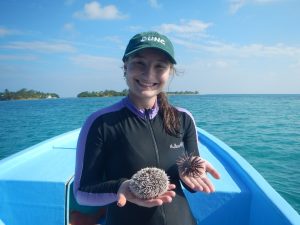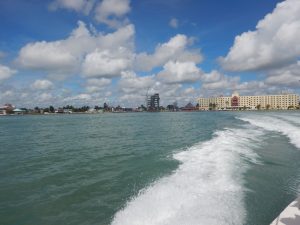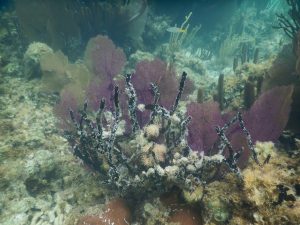I’m pretty sure that anyone reading my posts is kind of tired of me starting all of them with something like “OMG TODAY WAS SO AWESOME,” but seriously, today was so awesome, and I don’t even like the word awesome. It’s such a boring, generic word, but I can’t think of anything else that accurately sums up my feelings.
This morning, we headed out to the fore reefs (area outside of the lagoon) beside one of the cayes nearby, as well as a fore reef beside the island that we’re staying on. The fore reef was much deeper than the places we previously visited, maybe ~30 ft deep. The current was much stronger here than in areas we’d visited before, but I actually really enjoyed bobbing up and down on the waves (shout out to my dad for teaching me to swim)!
The benthos was covered with coral rubble, live hard and soft corals, and all forms of fish. If I listened carefully, I could hear colorful parrotfish crunching at the coral below. I spotted a southern stingray rippling along the floor and a Nassau Grouper, which is a highly protected endangered species of fish. AhhhhHHH watching a healthy coral reef teeming with life makes the heart happy 🙂
 Coral reefs make a great photo op!
Coral reefs make a great photo op!
After stuffing ourselves with homemade pizza for lunch, we headed out for my favorite part of the day: sea urchin collection! As the resident Echinodermata expert on this trip, I was kind of obliged to geek out about them. But really, sea urchins are so fascinating that I didn’t even have to pretend.
We headed out to the same shallow patch reef that we visited two days ago. This patch reef is inside what’s known as a Marine Protected Area, which is an area in which harvesting is prohibited but recreational activity is allowed. We got 25 minutes to search for and catch as many sea urchins as we could with the goal of comparing the urchins we found in the MPA to the ones we found later when we visited the non-MPA.
Those little guys were so hard to catch. They’re super spiny and like to hide in inaccessible reef crevices as well as under rocks. There’s a technique to catch them easily, but it requires extreme precision and lack of fear of stabbing oneself with a spine, neither of which I possess. You just have to reach in, grab a spine, and jerk sharply – but if you don’t dislodge the urchin on the first try, it’ll become almost impossible to grab. Its tube feet will reach out and suction to the rock when it senses danger.
I learned how to catch the urchins pretty quickly! I caught so many reef urchins and slate pencil urchins by turning over pieces of coral debris and picking them off the benthos below. They were adorable, especially the baby ones that were smaller than a centimeter in diameter!!
A bonus of turning over coral debris was that we found so many brittle stars, which are another type of Echinoderm. I know for sure that I saw at least 2 spiny ophiocomas and many Suenson’s brittle stars, but there were many others that I could not identify. They wriggled away and dropped their arms too quickly.
 A tiny green brittle star that I couldn’t identify.
A tiny green brittle star that I couldn’t identify.
I think the catch of the day was a West Indian Sea Egg that Claire found at the MPA patch reef. It was 9 cm in diameter and had a dark purple body covered with short white spines.
 Here I am holding the West Indian sea egg that Claire found! Isn’t it cute? What an egg.
Here I am holding the West Indian sea egg that Claire found! Isn’t it cute? What an egg.
When we got back to the island and after we finished dinner and lectures, we raced crabs that we caught on the island! We dubbed it “Crab Derby,” or “Dermit Crab Race.” Each of us caught either a Caribbean Blue Crab or a hermit crab, lined them up, and let them race towards a finish line.
Once the starting time was called, there was a sudden cacophony of screams of encouragement as each of us egged on our crabs. I’m proud to announce that my hermit crab, Georgiano, won second place! He made me so proud :’)
I’ll be awake again bright and early for another packed day tomorrow, so good night!














 Coral reefs make a great photo op!
Coral reefs make a great photo op! A tiny green brittle star that I couldn’t identify.
A tiny green brittle star that I couldn’t identify.  Here I am holding the West Indian sea egg that Claire found! Isn’t it cute? What an egg.
Here I am holding the West Indian sea egg that Claire found! Isn’t it cute? What an egg. 
 A beautiful coral formation I found at the patch reef!
A beautiful coral formation I found at the patch reef! If you look closely at my hands, you can see a tiny sea urchin! 🙂
If you look closely at my hands, you can see a tiny sea urchin! 🙂

